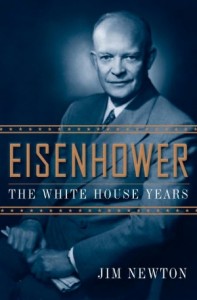Did you like Ike? If you are old enough to remember when he was president, you probably don’t have any negative memories of Dwight D. Eisenhower. Maybe not any particularly positive ones, either. He was just there, the president, old reliable.
Paul O’Connor, who’s barely old enough to have memories of Ike, reviews a book that shows us the virtues of being reliable and maybe even a little bit dull.
Prepare to feel wistful.
By Paul T. O’Connor
EISENHOWER: THE WHITE HOUSE YEARS. By Jim Newton. Doubleday. 357 pages, hardcover. $29.95
 When 21st Century Americans recall the 1950s, they remember Ozzie and Harriet, beatniks, Elvis, and an innocent time led by a grandfatherly president who played a lot of golf.
When 21st Century Americans recall the 1950s, they remember Ozzie and Harriet, beatniks, Elvis, and an innocent time led by a grandfatherly president who played a lot of golf.
I recall nightmares prompted by a popular TV playhouse episode in which survivors of a nuclear holocaust died slowly of radiation sickness.
And, I remember Ike, the president. He was dull. He was old, and he was in black and white. And, while the American people loved Ike for the victorious leader he’d been in Europe during World War II, they were so ready for that charismatic Irishman who replaced him in 1961. They wanted some glam.
What Americans lost in 1961, when John Fitzgerald Kennedy replaced Dwight David Eisenhower as president, was a steady hand, a wise and experienced leader.
Americans of the day knew generally that they had such a man as their leader, but their grandchildren today most likely don’t understand how wise and steady Ike was, how he navigated this country through truly perilous days, delivering us safely into the ’60s.
Jim Newton opens his Ike book by recounting May 1,1958, a day about which the political press – a worthless collection of no-talents even to this day – reported only that the president played golf. Yet, on that particular day, now-declassified records show, Eisenhower held steady before the National Security Council on a key question, refusing to overreact and drive the nation into the dangerous waters of nuclear war.
To read this book is to understand anew just how wacked out this country was in the 1950s. We experienced a red scare redux as feverish as that of the 1920s but very much more dangerous because it occurred in the nuclear age. Some American military leaders wanted authority to use nuclear weapons on the battlefield without civilian, or even Pentagon, approval. There were calls to use the bomb in Korea, against the Chinese during the Quemoy and Matsu crisis and even to help the French, who were surrounded at Dien Bien Phu.
When his first term began in 1953, Eisenhower did not yet totally understand, as we do now, the full implications of using any nuclear weapon, no matter how small and in however limited a situation, on a battlefield. The implications of using the bomb when the other side also had one had not totally sunk in. But over the years, it would, and Ike would repeatedly refuse to loosen his hold on the button.
Eisenhower was a very conservative man for his day – that’s when “conservative” meant something different from today. He preferred what Newton calls a “middle course” on most matters. He’s what we’d call a consensus leader today – if we had such reason to use the term. Thus, he was for holding out the threat of nuclear war while not being willing to use the bomb unless attacked.
He was also of a middle course on civil rights and on appointments to the Supreme Court. He believed in infrastructure investments, foreign aid and good schools.
Newton has not written the most exciting book of our times. It’s kind of like Ike – a little dull even with great material. The most entertaining sections deal with Nikita Khruschev. The book suffers from a somewhat rigid chronological flow and rather bland writing. But that is not to say that it isn’t worth the time to read it.
Americans have let the popular image of the 1950s replace their real understanding of the challenges we faced then and the very real dangers that might have led to global obliteration. This book is worth reading if for no other reason than to be reminded of the real world of the 1950s.
- Paul T. O’Connor, contributing editor, is a university lecturer who is available for freelance writing assignments. Contact him at ocolumn@gmail.com.